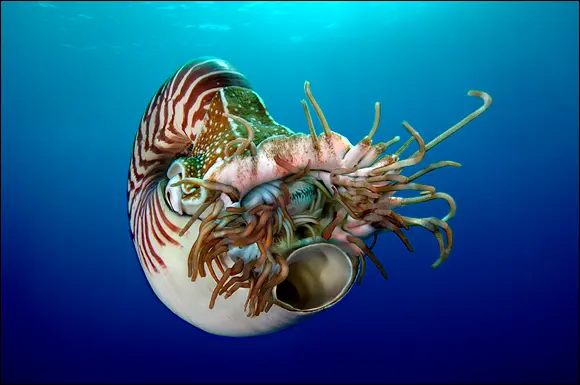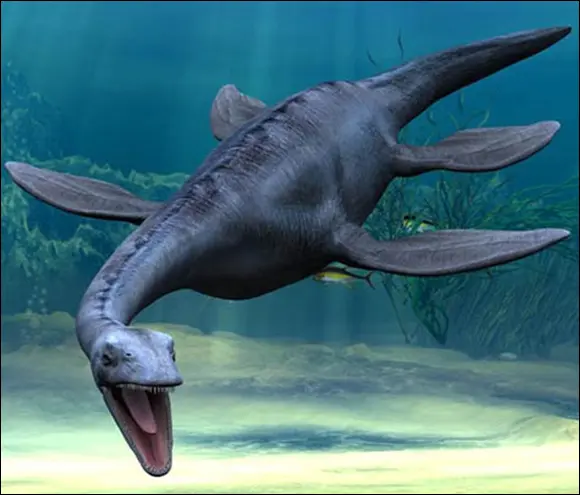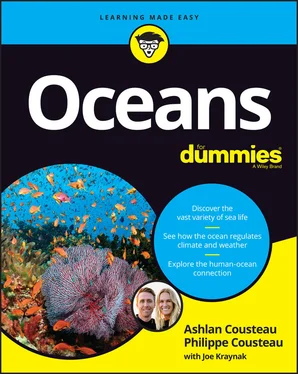Amphibians evolve.
Coelacanths (large, plump, lobe-finned fish) evolve and are still around to this day. See Chapter 12for a cool photo.
The first spiders and other insects appear, this time for sure.
Crinoids, corals, brachiopods, ammonite relatives, and ostracoderms are present and accounted for. Ammonites have a shell like a snail and a body like a squid.
The first complex land ecosystems begin to develop.
The Late Devonian Extinction marked the end of the party, occurring in at least two phases due to drops in oxygen levels in the ocean. Even the trilobites and placoderms had a tough time surviving this mass extinction.
The Carboniferous period (from 358.9 to 298.9 million years ago) was marked by a warm, humid climate with loads of oxygen and lots of forests, making this period famous for its swamps. Some animals called amniotes, began laying eggs with shells on land; these are the early ancestors of reptiles, birds, and mammals. But it wasn’t all about them; arthropods (insects) also began to take over the land — think giant dragonflies the size of seagulls.
Meanwhile, back in the ocean:
Sharks begin their massive diversification with about 45 families emerging.
Coral reefs flourish again, and invertebrate marine animals are common. Foraminifera (single-cell organisms with shells) become common.
Nautiloids emerge, and while they represented a very diverse group of predators at the time, today only their ancestor the Nautilus remains (see Figure 3-4).

Source: Laurent Ballesta – laurentballesta.com
FIGURE 3-4:Modern Day Nautilus, which is still surprisingly similar to what they would have looked like in the past. This photo was taken at 110 meters (360 ft).
This period ended as the continents started to merge to form the most well-known supercontinent, Pangea. Because inland areas of this massive continent were too far from the ocean to get any moisture, large deserts emerged in Pangea, and forests died out (the carboniferous rainforest collapse ). The amniotes we mention above (early reptiles) were better able to adapt to this drier climate and continued to diversify, while creatures that had dominated in earlier, wetter periods, such as amphibians, struggled.
Earth’s climate continued to get hotter and drier during the Permian period (298.9 to 251.9 million years ago). The seas were mostly still warm and shallow, and ocean life was similar to that of the Carboniferous period. While ammonoids (early marine mollusks) became more complex, not much else really changed. Sponges and corals made reefs, Bryozoa (moss animals) emerged, fish, ammonoids, gastropods, brachiopods, and echinoderms were still common.
All was hunky-dory till about 252 million years ago, when the Permian period ended with “the Great Dying” — Earth’s most extreme extinction event ever . Ninety-six percent of all marine species and 70 percent of all terrestrial species were wiped off the planet. Talk about a sad ending! This mass extinction event was most likely caused by one or more of the following:
Climate change due to a mass release of methane into the atmosphere from the oceans
Volcanic activity/eruptions in Siberia
A really big rock slamming into the Earth (a large crater matching the age of this event has been found near the Falkland Islands off the coast of Argentina)
And on that happy note, we come to the end of the Paleozoic era … but think about all the good times we had: the diversity of life-forms exploded, plants and animals spread from sea to land, and everyone’s favorite super-continent, Pangea, was formed. It also set the stage for … wait for it …
Gaining momentum in the Mesozoic era
Sorry, are you still waiting? The Mesozoic era (from 252 to 66 million years ago) is known as the Age of Reptiles or, for you terrestrial loving tree-huggers, the Age of the Conifers, not to mention the freaking DINOSAURS!!!!! This era is divided into only three periods (phew).
Spoiler Alert:If you want to skip the next few sections, here’s the plot summary: Early mammals, birds, amphibians, bees, and flowering plants evolved. Dinosaurs took over the planet (woohoo!), then all non-avian (not birdlike) dinosaurs went extinct (booo!). The Mesozoic marine revolution occurred, during which shell-crushing marine reptiles evolved, causing organisms with shells to grow stronger, spinier shells in self-defense, which sparked an evolutionary arms race that continues to this day.
The Triassic period (from 251.9 to 201.3 million years ago) was a time of rebuilding. After the Great Dying, few creatures remained. (Talk about a shrinking dating pool!) So, who was left? Temnospondyls (early amphibians) and therapsids (early relatives of mammals) made the cut, as did some fish, including some small sharks, and some mainly amphibious marine reptiles. Most animals living in shells fared poorly due to ocean acidification, which hinders the ability to form shells (more on that later). Hinged brachiopods, crinoids (sea lilies), and some ammonites (early mollusks) did okay.
During this period of rebuilding:
The first ichthyosaurs (fishlike reptiles) evolve, probably from terrestrial ancestors that returned to the ocean; for example, the cartorhynchus (say that three times fast) has flippers like a seal and a tail like a lizard. Ichthyosaurs were predators, feeding on fish, shellfish, reptiles, and other ichthyosaurs. Some were ram feeders, like today’s whale shark, swimming toward their prey with mouth open to engulf the prey and the water around it. Others could crush shells or bore into them.
Archosaurs (which means ruling reptiles ) appeared on the scene. Broadly classified as reptiles, this group includes all extinct dinosaurs along with birds and crocodiles.
The archosaurs split into two groups: Saurischia (lizard-hipped) and Ornithischia (bird-hipped).
The plesiosaurs arrive — large marine reptiles with four flippers, a long neck, and a long tail (see Figure 3-5).

Source: National Park Service, Public Domain
FIGURE 3-5:An average, everyday plesiosaur.
This period abruptly ceased with the End-Triassic Mass Extinction, also known as the Triassic-Jurassic (T-J) Extinction event. Around the same time, Pangea started to break apart, with North America drifting off first. These were triggered by massive shifts in the tectonic plates which caused an enormous spike in volcanic activity and a resulting increase in greenhouse gasses, which really cranked up the heat. This particular mass extinction caused the loss of the temnospondyls (sort of like salamanders), therapsids (mammal-like reptiles), and most ichthyosaurs (though some larger species survived).
The Jurassic period (from 201.3 to 145 million years ago) is everyone’s favorite (thank you Michael Crichton and Jeff Goldblum!). Because you’ve probably seen the movie, we’ll keep it simple … ish. During this period:
Ornithischians (vegetarian dinosaurs with bird hips) begin to spread and diversify.
Adaptations to leg and pelvic bones allow for a larger gut and, hence, larger teeth to help fill that gut, ultimately resulting in larger dinosaurs.
Читать дальше














